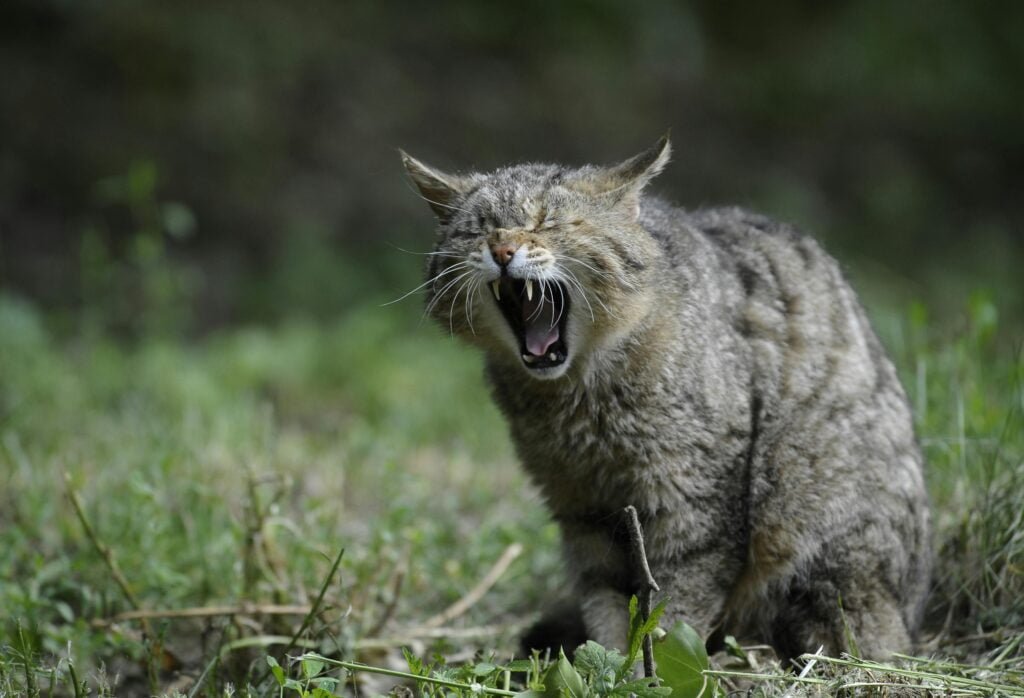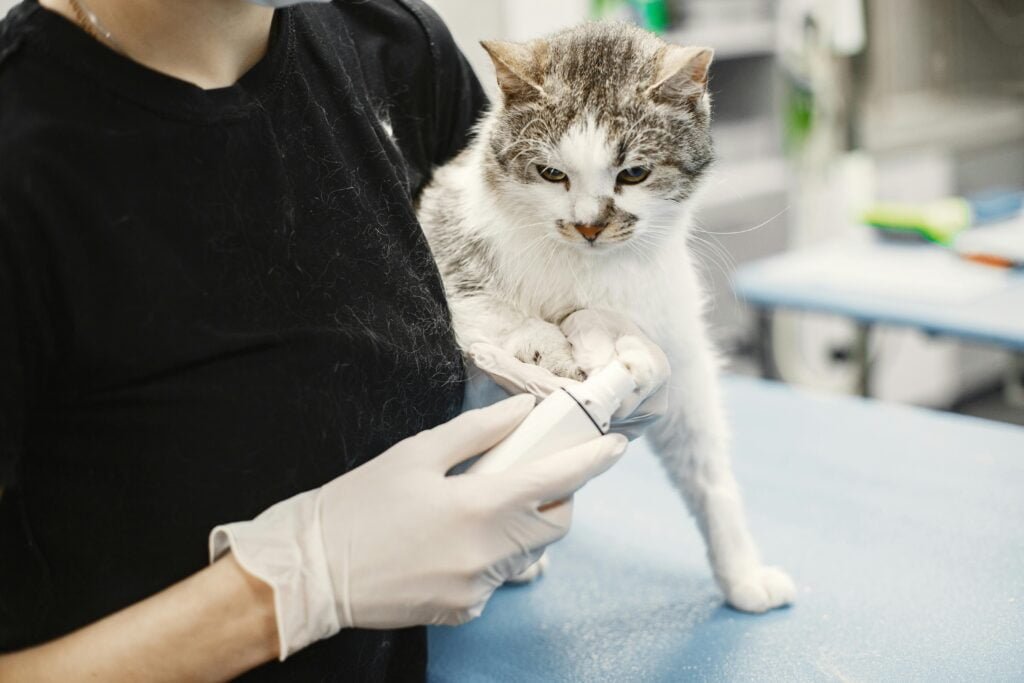
Cat asthma is a condition that affects cats all over the world. It is also a complex condition, and cat parents often misunderstand it. Loving cat parents have a responsibility to understand cat asthma. This understanding will help you protect your cat from serious respiratory issues.
Are you hearing about cat asthma for the first time?
We know it is scary to imagine your beloved cat in respiratory distress. But don’t worry; we are here with our comprehensive blog on cat asthma to help you. We are going to tell you all about the causes, symptoms, and treatments of respiratory issues.
Have you already dealt with cat asthma? Read on, and you might find some new information!
What is Cat Asthma?

Cat asthma is also commonly known as Allergic bronchitis or bronchial hypersensitivity. It is a chronic respiratory condition of the lower airways (bronchi and bronchioles) of the cat. All cats are at risk of cat asthma irrespective of their age, breed, and lifestyle. The inflammation of the airways results in several physiological changes.
The first such change is the constriction of airways. When the airways have inflammation, it makes the smooth muscles around them tighter. So, the passageways for air become tighter. When the airways are inflamed, they produce excess mucus. This causes further obstruction of airflow in the lungs. Inflammatory cells such as eosinophils can accumulate in airway walls. This accumulation further aggravates the inflammation.
These physiological changes of cat asthma cause difficulty in breathing. Sometimes, it’s a mild and intermittent difficulty. But, if not treated, it can become severe enough to threaten your cat’s life.
When your cat is exposed to the triggers, these symptoms can suddenly worsen. These reactions are known as asthma attacks or exacerbations.
The Immune System’s Role in Cat Asthma
Cat asthma is an allergic disease. So, the immune system has a significant influence on its development. If a cat has asthma, then its immune system overreacts when it comes in contact with the triggers. When the cat inhales the allergens, the immune system perceives these substances as threats. To deal with this perceived threat, the cat’s immune system triggers an inflammatory response in the airways. This inflammatory response results in cat asthma.
Prevalence and Risk Factors of Cat Asthma
Asthma affects about 1 to 5% of cats. Some factors do increase the cat’s risk of respiratory complications. Cats of all ages can develop asthma. But, the young to middle-aged cats of 2 to 8 years of age are at a higher risk. Similarly, any cat breed can develop asthma. But some breeds, such as the Siamese and the Himalayan, have a predisposition for cat asthma.
The household allergens or the allergens in your house and artificial chemicals are more likely to trigger cat asthma. So, indoor cats have a higher risk of exposure to household allergens. It increases their risk of cat asthma. Overweight or obese cats are also at a higher risk of developing respiratory issues. This includes asthma. There is no conclusive evidence to prove it. Still, some studies do suggest that female cats are at a higher risk of developing asthma.
6 Symptoms of Cat Asthma

As a cat parent, you must learn to recognize the symptoms of cat asthma as early as possible. Because if you catch these symptoms early, you can start the treatment early. This will help your cat recover without many complications. Early interventions are helpful for effective management of asthma symptoms, as it is a chronic disease.
The symptoms differ from cat to cat in how severe they are and how frequent they are. And all cats will not exhibit all the symptoms. They might exhibit only one or a couple of the symptoms.
Please keep in mind that these respiratory distress symptoms may not always indicate cat asthma. Other respiratory issues or temporary allergies can also cause these symptoms. Sometimes, your cat might have these symptoms occasionally, and they might be mild. Still, at other times, they could be severe and life-threatening. Regular monitoring and keeping an eye out for these symptoms will help you respond to your cat’s distress properly.
1. Coughing
Usually, coughing is the first and most common symptom of cat asthma. It is also the most noticeable symptom. A cat with asthma will have a dry and hacking cough. It will be similar to the sound a cat makes when trying to expel a hairball. However, unlike with hairballs, the cat will not spit out anything. The cough that your cat has might vary in severity.
When your cat has asthma, the cough will be persistent or intermittent. It might occur throughout the day or in periods of severe coughing. This coughing is more frequent at night and early in the morning. Your cat might also cough during exercise or excitement, often accompanied by a wheezing sound.
Many cat owners mistake this cough for hairballs. They think the cat is trying to expel a hairball and ignore it. However, if the cough persists for a couple of days, you should investigate further. Even if it turns out to be a hairball, if the cat is struggling to expel it with persistent coughing, it definitely needs medical help.
2. Difficulty Breathing
When your pet has cat asthma, its airways will be restricted due to inflammation, leading to difficulty breathing or respiratory distress. This is especially noticeable during an asthma attack. The first sign is rapid breathing.
Normally, a cat’s respiratory rate is 20-30 breaths per minute. Still, during an asthma attack, this rate will increase significantly, making it visible as the cat struggles to breathe. The second sign is labored breathing, where the cat puts in extra effort to breathe. You will see its chest and abdomen moving noticeably more than usual as it struggles to inhale and exhale.
The third sign is shallow breathing, where the cat takes quick, shallow breaths and cannot take deep breaths. The last sign is breathing with an open mouth, which indicates severe respiratory distress. If you notice your cat breathing with an open mouth, seek medical attention immediately.
3. Wheezing
When your cat has asthma, it will make a wheezing sound while breathing. This sound may occur when it inhales or exhales and will be a high-pitched whistling noise. Asthma causes the airways to narrow, making it difficult for air to pass through. The wheezing might be barely noticeable or quite a loud noise.
This type of wheezing is especially noticeable during an asthma attack. And can also be heard when your cat is resting or trying to take deep breaths. If you hear these wheezing sounds, it is likely a sign of cat asthma. Consult a vet immediately for proper diagnosis and treatment of respiratory distress.
4. Lethargy and Reduced Activity
When your cat is affected by asthma, its airways are restricted, making it difficult for your cat to breathe comfortably. This respiratory distress can lead to decreased energy levels, so your cat may show less interest in play or exercise.
You might notice that your cat is reluctant to climb or jump on perches and is less interested in interacting with other pets or with you. It will spend more time sleeping and resting, and even if it engages in some activity, it will tire very easily.
5. Changes in Body Posture
Cat asthma often results in changes in body posture. When a cat has difficulty breathing, it affects its whole body, not just the lungs. To deal with this difficulty in breathing, the cat might adopt certain postures. These changes in posture serve a dual purpose. The first is to help them get more air, and the second is to ease the pressure on the lungs.
The first physical adjustment that your cat makes to deal with asthma is the hunched position. In this position, the cat will sit with hunched shoulders and an extended neck to draw breath. The second position is squatting with the elbows out, also known as the tripod stance. This position helps open up the chest and allows the cat to take deep breaths.
The third position is lowering the head and extending the neck, which helps to straighten the airways and make breathing a little bit easier.
6. Other Changes in Behavior Caused by Cat Asthma
When your pet has cat asthma, its body will make certain changes in behavior to deal with the symptoms. These changes are not always directly related to the respiratory system. But you can always see your cat exhibiting this behavior during an asthma attack.
The first change is alarming behavior is vomiting. Your cat might vomit because of the force of coughing. When your cat has asthma, the difficulty in breathing and the general discomfort can cause a loss of appetite.
When the airways are restricted in severe cases, your cat experiences a lack of oxygen. This can lead to a condition called cyanosis. The cat’s gums will have a bluish or greyish tint, and the tongue might also become blue or grey. If you see these signs, it’s a medical emergency. You should promptly seek help from a veterinarian.
Cat asthma also results in excess mucus production. After coughing fits, this mucus can get stuck in the cat’s throat. As a result, the cat will swallow more frequently to clear the mucus. When the pet has asthma or chronic respiratory distress, it will be very irritable. It may withdraw from social interactions, and you might notice that your cat is hiding more than usual.
You will notice that even if your cat is not wheezing, it may have a loud breathing sound. Especially when it is sleeping or resting, you can clearly hear this loud and noisy breathing.
Causes of Cat Asthma

As we mentioned at the beginning of the article, asthma is a complex condition. So what makes it so complex?
First of all, we do not know the exact etiology of cat asthma. So, we do not know the cause or origin of the condition. The general theory is that it results from a complex interaction between genetic risk factors and environmental factors.
What does this mean? It means that some cats have a genetic susceptibility to asthma. When exposed to environmental triggers, asthma attacks can occur. Understanding the causes of asthma is crucial. It will help you manage its symptoms better and support your cat through long-term treatment.
There are three major factors or causes behind cat asthma. If you know about these triggers, you can protect your cat from asthma attacks and manage their condition better.
1. Allergens
Allergens are substances that trigger an allergic response. When your cat inhales these allergens, it can trigger an asthma attack. The most common allergens are dust and dust mites. Dust mites are microscopic creatures found in bedding, carpets, or furniture. They thrive in warm, humid environments, and their feces and decomposing bodies can become airborne, triggering an asthma attack when your cat breathes them in.
Another allergen is pollen, which comes from trees, grasses, and weeds. Pollen can irritate the airways of an asthmatic cat, with seasonal variations in pollen counts affecting asthma symptoms. If pollen triggers your cat’s asthma, you’ll notice it more during certain times of the year.
Mold is also a common allergen. It thrives in damp, dark areas like basements and bathrooms with poor air circulation. When mold spores become airborne, they can trigger asthma attacks in your cat.
Interestingly, cats can be allergic to dander from other pets. In a multi-pet household, your cat may inhale dander from other cats or dogs, leading to respiratory irritation. Feathers from down pillows or feather dusters can also trigger asthma allergies in some cats.
First-hand and second-hand smoke can irritate your cat’s airways and aggravate asthma symptoms. Many household products contain chemicals, including cleaning products, air fresheners, and perfumes, which can release volatile organic compounds (VOCs) that your cat may inhale, leading to asthma attacks or respiratory distress. Some types of cat litter, especially clay-based ones, produce fine dust that can also irritate your cat’s airways.
Environmental Factors
As we mentioned at the beginning of this section, asthma results from a complex interaction between genetics and environmental factors. Allergens are a significant environmental factor, but there are other triggers as well.
Air pollution, such as vehicle exhaust and industrial emissions, can trigger an asthma attack in your cat. Fumes from cooking or a fireplace can also irritate your cat’s respiratory system. Sudden changes in temperature and humidity can provoke asthma attacks. Both cold, dry air and hot, humid conditions can be problematic for cats at risk of asthma.
Stress is another trigger. Just like in humans, stress can cause asthma flare-ups in cats. Moving to a new home, adding a new pet, or changes in routine, such as returning to work, can stress your cat and trigger asthma symptoms.
Obesity increases the risk of respiratory issues, including asthma. Excess weight puts additional pressure on the lungs and diaphragm, making it harder for your cat to breathe. Respiratory infections caused by viruses or bacteria can either trigger asthma attacks or aggravate existing symptoms.
While regular physical activity is beneficial for your cat, excessive or intense physical activity can also lead to asthma attacks.
Genetic Factors
Genetic factors can also increase the risk of asthma in some cats. Certain breeds, such as Himalayan cats and Siamees, are more prone to developing asthma. Additionally, some cats may have a genetic tendency toward a more reactive immune system. When the immune system is overly sensitive, it can react to minor allergens with severe inflammation, making the cat more likely to experience frequent asthma attacks.
Some cats may inherit airway hyper-responsiveness, a condition where the airways are extremely sensitive and react aggressively to irritants. Even the slightest triggers can lead to an asthma attack in these cats.
Diagnosis and Treatment of Cat Asthma

The diagnosis and treatment of asthma is a complex process. The diagnosis of asthma is challenging because the symptoms are not always consistent. Sometimes, your cat might not exhibit any symptoms of asthma at all when you are at the vet. The symptoms that the cat exhibits are similar to other respiratory distresses.
There is no cure for cat asthma, but you do have various treatment options that will help you manage the symptoms. With timely and proper medical intervention, you can reduce the severity of asthma attacks. By a combination of lifestyle changes of avoiding the triggers along with medication, you can also reduce the frequency of these asthma attacks. So, you have options to improve the overall quality of life for your cat, even if it has asthma.




